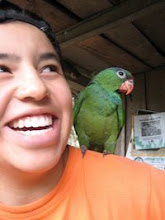

So this is Orientation part 2. Time to share a couple more stories.
Last weekend, all of the fellows plus Kip, our field officer, went to the Nicaraguan beach – in this case the Eastern Coast /Pacific Ocean beach. We rented a mini-bus (very easy to do here, just talk to the driver) and headed out to a place called “La Boquita”, literally, ‘little mouth’. Unfortunately, I don’t know why it is called that. The place is a collection of restaurants that all border the sand – so we just went into one, took over a few tables and ran into the water. The waves were huge! They were good for surfing. Not that I surf, but I enjoyed them lots. The water was pretty warm and the other fellows and I had a good time trying to body surf. I brought my Frisbee (surprise surprise) and some of us threw that around for a while. Horses kept passing through the area, either with riders or pulling carts, and some people were playing soccer. We had lunch at the restaurant and I had a soup that had crayfish in it. Quite tasty. I also took care of all my napping needs in one of the restaurant’s comfy hammocks. On the way back to Jinotepe (probably about an hour and a half drive) the bus suddenly overheated and stalled. Smoke was coming out of it, and we all raced out. It was just about time for a refreshing beautiful sunset, and none of us were too bothered by waiting an hour for the bus to cool down. We found ourselves in a rural area surrounded by some fields and some cows and lots of green. We had fun amusing ourselves with more Frisbee, taking crazy pictures of each other jumping in the air and holding an impromptu dance party next to the road. A few cars passed by but none of them stopped. Eventually we all pushed the car until the driver could start the motor up again but we didn’t trust that car to carry us all the way back. We boarded a second bus for a cramped drive home characterized by lots of singing.
My final story should be titled ‘not blending in can be no fun’ and I write with much sympathy towards my fellow fellows, who I’m sure will all mention this same topic in their blogs. Also worthy of mention is the group demographic: 11 people – 1 of whom is male and 1 of whom is non-caucasian (me). As our group has unfortunately learned, due to the existence of Nicaraguan machismo culture, it is very commonplace for men to harass perceived attractive women in the street. Machismo culture dictates that men can’t be held responsible for their carnal desires, thus there is nothing wrong with whistles, dirty comments/noises, grabbing etc of aforementioned attractive women. Foreign (white) women are stereotyped to be both attractive and easy, and frustratingly, all of my fellow gringas have been subject to such harassment, which is an uncomfortable and often scary experience. For once I find myself in a majority, my skin being the perfect personal camouflauge, slightly destroyed only at the moment I open my mouth to say something in Spanish. I weave in and out of being a foreigner – I don’t ever attract any attention when alone, but I therefore really notice the difference when I’m walking with the others. I’ve gotten into the habit of making sure I mention being born in Guatemala when Nicaraguans ask me where I’m from, because they react very warmly whenever I do so. However, any mention of Namibia, Africa results in either blank stares or strange questions. “There’s a lot of black people there?” I sometimes wonder how I would be treated if my skin were black yet I had the exact same life story as I do now. I get the impression that in Central America there exists quite a bit of racism against black people.








